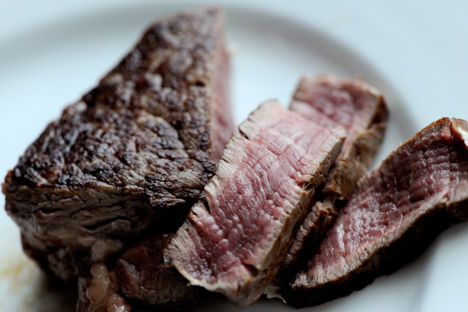Beef has always been our go-to protein for a big occasion – just witness the triumphant nature of the beef Wellington, while we weren’t called the ’rosbif’ by the French for nothing.
If beef has been overtaken by chicken in recent times it is mainly because the latter is more affordable and perhaps a little lighter, but as chefs will tell you – beef is still the nation’s favourite
What to look for when buying beef
Always buy beef from a decent butcher that knows the provenance of the meat being sold, and always opt for organic meat if you can, preferably from British or Irish farms. As well as the more common breeds such as Aberdeen Angus and Welsh Black, rare-breed beef is also becoming more widely available, with breeds such as Dexter and Beef Shorthorn becoming more popular due to their intense flavour.
The key to tasty beef lies in the fat distribution – this imparts flavour and moisture into the meat, so look for cuts with marbled fat throughout. The length of time the meat has been hung for also has a huge impact on the flavour and tenderness of the beef. Hanging beef for a longer time breaks down enzymes in the flesh, and causes water to evaporate from the meat. After a good long hanging, the meat becomes a deep-red/brownish colour, with relaxed, tender fibres and an intense flavour. Beef should be stored covered in the fridge for a few days, or frozen.
How to cook beef
Different cuts of beef require different methods of cooking, due to the different structures of muscle fibres and fat distribution in the animal.
When cooking beef, always season it first. You can keep it simple with salt and pepper, or rub garlic, herbs or spices into the flesh.
Use a meat thermometer; it will help determine what stage the beef is cooked to, from rare to well done, and gives a more consistent result.
Allow the meat to come up to room temperature before cooking and leave it to rest for at least 10–15 minutes after cooking – this allows the juices to spread throughout the meat, resulting in more succulent and tender meat.
Beef suitable for slow-cooking tends to have a high fat content, longer muscle fibres and more connective tissue, which is broken down in slow cooking. The most common cuts of beef for slow cooking include beef topside, braising beef, shin, cheeks, oxtail, and brisket.
Once the tough fibres are broken down from a slow-cook, these cuts, ignored for a long time, are some of the most flavoursome around.
Pot-roasting, stewing and braising are all excellent methods for slow-cooking beef. Brining beef is also great for achieving a tender finish – brisket is submerged in a flavoursome brine for a week to make classic salt beef.
Tender cuts of beef are better suited to quick cooking, either by quickly pan-frying, barbecuing or lightly roasting in the oven. A hot, direct heat is necessary to cook the beef quickly, but be careful not to overcook, as the beef will become dry and tough.
The cuts of beef which are most suited to rapid cooking are the parts of the animal that have had the least exercise, such as minute steak, fillet steak, tournedos, Chateaubriand, sirloin, rump, rib-eye, and porterhouse steaks, among others.
Beef can also be ground down into mince for quicker cooking, and flavoured with an assortment of herbs, seasonings and bindings to make burgers.
When cooking beef quickly in a pan or on a barbecue, flavour can be added by marinating the cut overnight.
What goes with beef
A mainstay of British cuisine, as well as in Ireland and much of Europe, beef is traditionally served with a variety of greens or root vegetables, which complement the natural tenderness of the meat.
For sauces, beef is often served with or cooked in a red wine or Madeira sauce. Marcus Wareing opts for a hybrid sauce, using both brandy and red wine in his roast sirloin of beef recipe.
If looking for something slightly different to serve with beef, why not use Luke Holder's Beef cheek and fillet recipe as inspiration, which pairs the meat with Dorset snails, or even Mark Jordan's recipe which uses lobster as a partner to Jersey beef fillet – both of which demonstrate the versatility of beef’s flavour.
For a slightly more down-to-earth beef dish, look no further than this steak tartare recipe or this homemade beef burger
Get in touch
Please sign in or register to send a comment to Great British Chefs.



